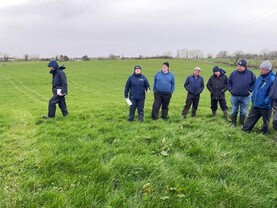Silage quality: Earlier housing and a faster depletion of grass reserves is bringing silage quality into focus for many at an earlier stage of the winter. The focus for most sheep farmers with mid-season lambing flocks at this stage is ensuring ewes are fed a maintenance diet and don’t lose valuable body condition. A 70kg ewe in mid-pregnancy will require in the region of 0.8UFL (1kg of air dry barley is equivalent to 1UFL) to satisfy maintenance demand.
The table shows energy values in UFL per kg dry matter for silage and hay of varying dry matter digestibility (DMD). On many sheep farms, silage quality is in the region of 65 DMD to 72 DMD, which is sufficient to meet maintenance requirements.
Ewes will typically need to consume about 1.1kg to 1.2kg silage dry matter, equivalent to 5kg silage freshweight at 20% dry matter or 3.5kg to 4kg freshweight at 25% to 30% dry matter. This will not be a problem with better-quality silage. Poor-quality, low digestibility silage however will depress intake in ewes and leave them unable to physically consume enough silage to satisfy nutritional demands.
If we take silage less than 60DMD as an example, which has been ensiled wet and as a result preserved poorly, ewes will, at best, only be capable of consuming 0.6kg to 0.7kg DM. Combined with the poorer feed value and ewes offered such silage will only be receiving 50% to 60% of their daily nutritional requirements. Such a scenario would have long-term detrimental consequences, with weight loss of 1kg or higher per week.
Ewes fed precision chop silage will be able to consume higher volumes. While hay typically has a lower energy value but is good quality, ewes can compensate somewhat by consuming higher volumes.
It is important as such to get silage tested, particularly where it is forming a large part of the winter diet. Grass reserves are disappearing quicker than anticipated. Ewes grazing on paddocks or consuming grass that has been saved through deferred grazing will generally be capable of consuming sufficient quantities of grass to meet intake requirements.
However, where utilisation is particularly poor or grass supplies are limited, then quick action through introducing silage supplementation or feed buckets/concentrates will be required to maintain body condition. Sticking to normal supplementation dates rather than monitoring feed supplies and ewe condition can be damaging in the long-term.
Refrain from feeding mouldy silage and avoid feed going stale to reduce listeriosis risk.
Silage quality: Earlier housing and a faster depletion of grass reserves is bringing silage quality into focus for many at an earlier stage of the winter. The focus for most sheep farmers with mid-season lambing flocks at this stage is ensuring ewes are fed a maintenance diet and don’t lose valuable body condition. A 70kg ewe in mid-pregnancy will require in the region of 0.8UFL (1kg of air dry barley is equivalent to 1UFL) to satisfy maintenance demand.
The table shows energy values in UFL per kg dry matter for silage and hay of varying dry matter digestibility (DMD). On many sheep farms, silage quality is in the region of 65 DMD to 72 DMD, which is sufficient to meet maintenance requirements.
Ewes will typically need to consume about 1.1kg to 1.2kg silage dry matter, equivalent to 5kg silage freshweight at 20% dry matter or 3.5kg to 4kg freshweight at 25% to 30% dry matter. This will not be a problem with better-quality silage. Poor-quality, low digestibility silage however will depress intake in ewes and leave them unable to physically consume enough silage to satisfy nutritional demands.
If we take silage less than 60DMD as an example, which has been ensiled wet and as a result preserved poorly, ewes will, at best, only be capable of consuming 0.6kg to 0.7kg DM. Combined with the poorer feed value and ewes offered such silage will only be receiving 50% to 60% of their daily nutritional requirements. Such a scenario would have long-term detrimental consequences, with weight loss of 1kg or higher per week.
Ewes fed precision chop silage will be able to consume higher volumes. While hay typically has a lower energy value but is good quality, ewes can compensate somewhat by consuming higher volumes.
It is important as such to get silage tested, particularly where it is forming a large part of the winter diet. Grass reserves are disappearing quicker than anticipated. Ewes grazing on paddocks or consuming grass that has been saved through deferred grazing will generally be capable of consuming sufficient quantities of grass to meet intake requirements.
However, where utilisation is particularly poor or grass supplies are limited, then quick action through introducing silage supplementation or feed buckets/concentrates will be required to maintain body condition. Sticking to normal supplementation dates rather than monitoring feed supplies and ewe condition can be damaging in the long-term.
Refrain from feeding mouldy silage and avoid feed going stale to reduce listeriosis risk.






 This is a subscriber-only article
This is a subscriber-only article









SHARING OPTIONS: